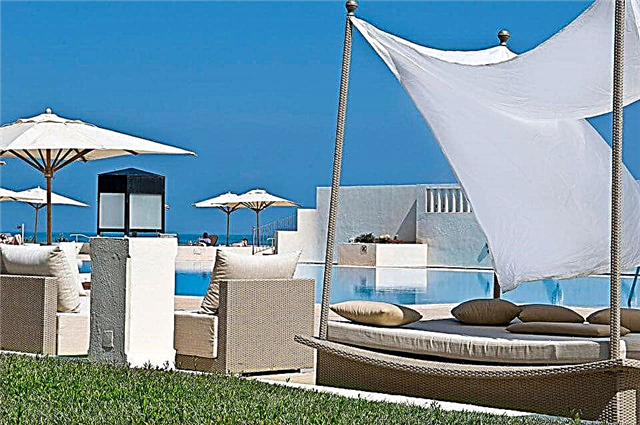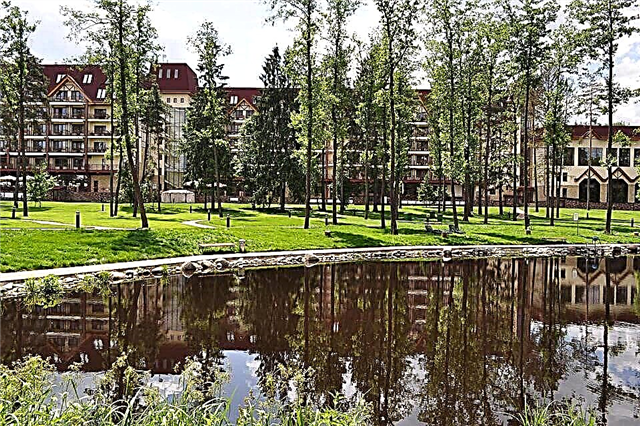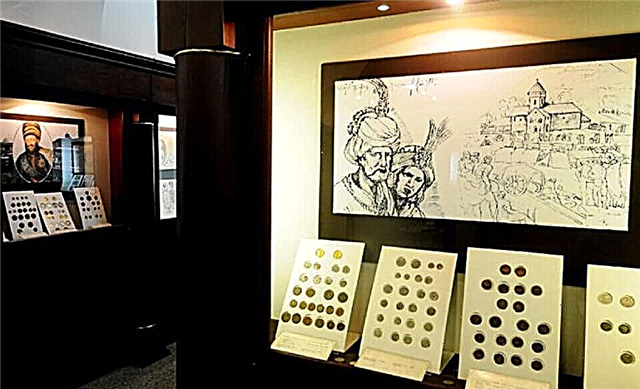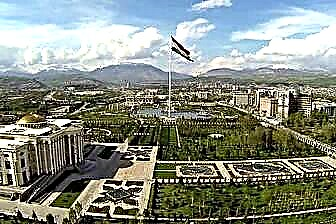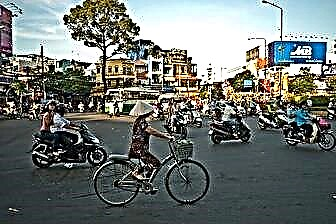Vietnam is a promising and constantly developing tourist destination in Southeast Asia. The country attracts millions of travelers with exotic, relatively cheap tours, high-quality beach holidays and a well-developed infrastructure. Tourism in Vietnam began to develop actively around the late 1990s. For almost the entire first decade of the 2000s, the bulk of travelers were Chinese, and only a small percentage were guests from Europe, America and other continents.
The country's territory stretches along the Pacific coast for about 2000 km. It is conventionally divided into North, Central and South Vietnam. Each of these parts has seaside resorts with beautiful beaches, quality hotels and interesting attractions.
People go to Vietnam mainly for a beach holiday. In any part of the country you can find hotels for every taste - from small, economical 2 * and 3 * to luxurious 5 * on the first coastline. Almost every one has a cozy garden with bright unusual flowers and plants, a small swimming pool. For those wishing to get to know Vietnam better, local travel agencies organize exciting excursions. Gourmets will not remain indifferent to traditional cuisine. Pho soup, nem pancakes, spring rolls, lau soup are basic dishes for the locals. Seafood is a separate item. In Vietnam, they are excellent and are sold at reasonable prices.

The best hotels and hotels at affordable prices.
from 500 rubles / day
What to see in Vietnam?
The most interesting and beautiful places, photos and a short description.
Ho Chi Minh City
It is a modern metropolis with a developed industry. Here you can feel the pulse of business Vietnam. Ho Chi Minh City is also called the "city of mopeds". In the mornings in the parks, residents do gymnastics, in the evenings they stroll in the square in front of Notre Dame de Saigon, the main Catholic cathedral in the south of the country. The city is named after Ho Chi Minh, the founder of the Communist Party and the first president of a united Vietnam.

Halong Bay
This bay is one of the most recognizable symbols of Vietnam. Almost every tourist brings a postcard depicting a ship with flying scarlet or brown sails against the backdrop of views of the bay. Halong is a bay with three thousand islands, grottoes, caves, cliffs, located a couple of hundred kilometers from the capital. The bay is classified as a UNESCO World Heritage Site due to its unique beauty.

War Victims Museum (Ho Chi Minh City)
This complex was created in order to show people all the horrors of the war with the USA in 1965-1973. The museum contains photographs of Vietnamese maimed by American chemical weapons (under the special name "agent orange"), instruments of torture, history of abuse of the local population, mass exterminations.

Kuchi Tunnels (Kuchi)
Underground labyrinth for about 250 km. These tunnels near Ho Chi Minh City served as a refuge and base for Vietnamese guerrillas. From here they made successful forays against the Americans. Cunning traps, weapons and household items of the soldiers who once lived here are presented to the attention of visitors.

Forbidden Purple City (Tu Kam Thanh)
It is of great historical interest, since the imperial family once lived here, and mere mortals could not get here. Tu Kam Thanh is located in Hue and consists of a complex of palace buildings, temples and gardens, many of which are hundreds of years old.

Temple complex Michon
Remains of Hindu temples of the Tyapma (Champa) Empire that once existed in Vietnam. Before the arrival of the Vietnamese, the land was inhabited by the Chams, who approximately moved here from the island of Borneo. From the IV century. Michonne was the capital of the Cham state.

Hanoi Citadel
A large cultural complex, where excavations are still underway. It began to be built during the Vietnamese Li dynasty in the 11th century. During its long existence, the territory of the citadel expanded, collapsed, rebuilt again, and only in the XX century. managed to begin full-scale archaeological work to extract valuable ancient artifacts.

Ho Chi Minh Mausoleum
The tomb of the national hero and socialist leader, Uncle "Ho", as the locals call him. This is one of the main modern attractions in Hanoi. In addition to the body of Ho Chi Minh, tourists are invited to look at the chambers where the leader of the nation lived and worked, as well as stroll through the magnificent park around the mausoleum.

Tienmu Pagoda
Seven-tier structure, symbolizing the moment of Buddha's enlightenment. It was created in 1601. Tien Mou is the tallest pagoda in Vietnam. Not far from the tower in the 60s. of the twentieth century, the Buddhist monk Thich Quang Duc performed the ritual self-immolation, who, together with his brothers, fought against the oppression of the Catholic ruler.
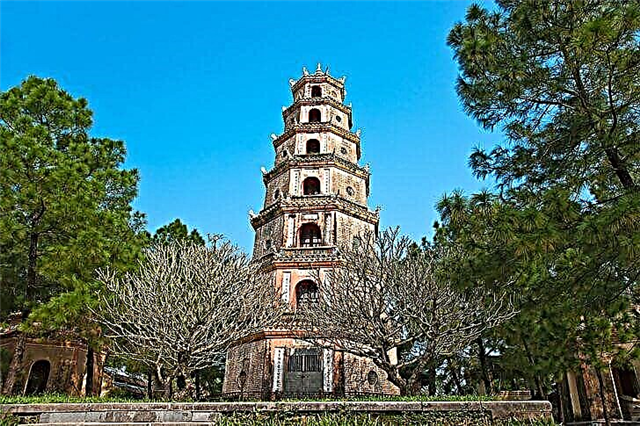
Cham Towers Po Nagar (Cham Towers)
Another architectural monument of the Tyampa period. This is a group of temples located in the city of Nha Trang. Some of them are still in operation, despite the fact that they are more than a thousand years old. From the observation deck on the territory of the temple complex, a vast panorama of Nha Trang opens.

Long Son Pagoda (White Buddha)
A temple with a large statue of a deity towering over all of Nha Trang. It can be observed from almost anywhere in the city; it seems to float in the clouds. There is a Buddhist monastery on the territory of the pagoda, services are constantly held. To climb to the statue of the seated Buddha (the highest point of the pagoda), you need to walk 150 steps.

One Pillar Pagoda in Hanoi
Another unusual temple during the reign of Li Thanh Tong in Hanoi. It was built in 1049 by a grateful emperor in honor of the goddess Kuan Am, who predicted the birth of his son in a dream. Today, only a small pagoda with a statue of Kuan Am, actually standing on one pillar, has survived from the entire building.

Tomb of Emperor Ty Duka
This is a complex in Hue, which includes a pavilion, a temple, a crypt, a courtyard of honor and a reservoir with lotuses. All these structures were supposed to emphasize the greatness of the ruler and perpetuate his name. It was Ty Duc who came up with the tradition of erecting tombs in this way. After him, many tombs of later rulers appeared in the vicinity.

Cathedral of Our Lady of Saigon
Another name for the temple is Notre Dame de Saigon. This is a piece of Europe at the very equator and the main Catholic temple in Ho Chi Minh City, built in 1880. Notre-dame-de-Paris was taken as a model during the erection. In the temple, you can attend the classic Mass, which is served by a Vietnamese priest in broken Latin, or simply admire the beautiful stained glass windows.

Nha Trang Cathedral
Another Catholic church built with the help of the French. She can be seen from almost anywhere in the city. This temple was built for many years and was completed by 1939. The construction turned out to be majestic and massive, designed to inspire the appropriate awe in front of divine power. Now it is the seat of the bishop, and Mass is regularly celebrated.

Hanoi Cathedral
The cathedral is another striking architectural monument reminiscent of the rule of the French throughout Indochina. In the Gothic outlines of the temple, European canons are easily guessed, and the interior decoration creates an atmosphere of awe.

Temple of Literature
One of the most striking sights of the capital of Vietnam. Emperor Li Thanh Tong ordered this temple to be erected in honor of Confucius in 1070. A few years later, a university was established on its basis for the offspring of high-ranking officials of the state. Here, the tourists will see thousand-year-old historical monuments: statues, a cult hall, the Gue Van pavilion.

Thap Ba thermal springs
Better known as the famous mud baths in Central Vietnam. Here they take baths from healing mud, swim in pools filled with hot mineral water, and do wellness procedures. You can also buy high-quality inexpensive cosmetics right there. For visitors, package offers are provided, which include a complex of spa treatments, fruit snacks and various additional options.

Cable car to Hon Che Island
It is considered the longest road of this type over the sea. It leads to the island where the popular Vinperl amusement park is located. The supporting structures are made in the form of French "Eiffel Towers", which are beautifully illuminated at night.

Monkey island
It is located 20 kilometers from Nha Trang and is a popular tourist attraction. These funny and unceremonious animals live everywhere, as at one time they bred uncontrollably and settled in a small area. On the island, you can not only watch monkeys, but also swim, sunbathe, and walk in quiet parks and gardens.

Marble Mountains in Da Nang
A whimsical joint creation of man and nature. Inside the natural rocks of unusual coloring there are huge halls with temples and altars. Outside, prayer houses and pagodas are scattered among the greenery. The Marble Mountains are not just a tourist attraction, but a sacred pilgrimage site for Buddhists.

Lake of the Returned Sword
In the center of old Hanoi, there is perhaps one of the most interesting sights of the city - Lake of the Returned Sword. Legend has it that a giant lake-dweller turtle during the wars with China gave a sword to the hero Le Lu, who defeated the enemy with it. Then the turtle took the sword back, hence the name.

Lotus Lake (Mui Ne)
A picturesque series of small freshwater lakes under the collective name Lotus Lake is located in the vicinity of the Mui Ne resort. They are notable for the fact that they are almost completely overgrown with lotus. It is especially beautiful on the lakes in the summer during the flowering period - during a walk, the visitor plunges into the "kingdom of the lotus".

White and red dunes
In the vicinity of Phan Thiet and MUI ne, there are a lot of sandy multi-colored dunes. The most grandiose are the white and red dunes - huge formations of sand, interspersed with sparse pine groves and lakes. When tourists get here, they feel like they are in an endless desert. Quad biking is the most popular pastime for visitors to the dunes.

Khe Ga lighthouse
Ke Ga lighthouse is located about 50 kilometers from the tourist area of the city of Phan Thiet. It was built during the French rule in 1899. Later it was recognized as one of the most beautiful in Southeast Asia. The lighthouse stands on a 25-meter rock, the structure itself is 41 meters high. The light from the generator is already visible 40 km from the coast.

Hang Nga Guest House (Mad House)
Dalat is home to one of the most unusual sights of the region - Hang Nga madhouse or crazy house. It was designed by the daughter of the Vietnamese politician Dang Viet Nga, who was an avid Gaudi fan. Now it is a hotel in the shape of a giant tree with aisle branches, rooms "cut" in the trunk, hanging gardens and statues of fabulous animals.

Winperl Amusement Park
According to local guides, this park is an upscale resort “without Asian exoticism”. In addition to attractions, a water park, a dolphin and seal show, an oceanarium, there is a 5 * hotel, excellent white sand beaches, and bright evening shows are constantly held.

Detian waterfall
It is located near the city of Cobang and is considered the most beautiful in the whole of Southeast Asia. Rice fields, mangrove-palm groves and cotton plantations are spread around Detian. The landscape is complemented by pointed peaks of rocks, which resemble the scenery for "Avatar" against the background of the blue sky.



